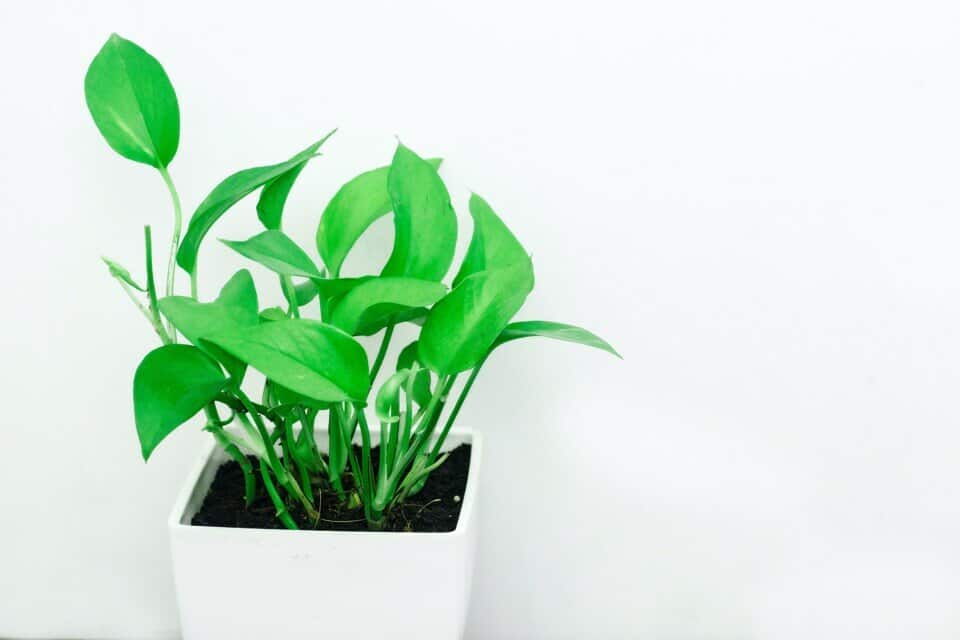Some links in the post are affiliate links and I get a commission from purchases made through some links found in the post.
A pothos in a small pot can make your indoor living space look aesthetically pleasing, but with time, you may start to notice an unusual change in the growth and overall health of this plant. This is because the accommodation for this plant is cramped.
Pothos does not like to be root bound as their root grow extensively and will require more moisture and nutrients to survive.
The best way to solve this problem is to repot this plant in a bigger pot to sustain the growth of the roots.
Leaving your pothos plant under this condition for a long time can cause it to wilt. This article explores all the symptoms of a root bound pothos, how to solve this problem and the right growing conditions for this plant.
What does Root Bound Mean?
 Root bound plants are plants that have filled out their containers and for a pothos plant, the roots will spiral around the soil because of a restricted space for growth.
Root bound plants are plants that have filled out their containers and for a pothos plant, the roots will spiral around the soil because of a restricted space for growth.
This is mostly a result of growing this plant in a small container for a long time or not repotting it when necessary.
There is often competition for moisture and nutrients between the roots of a root bound pothos.
There will also be inadequate oxygen in the soil for these roots to utilize, all of these causes stress to your plant which leads to hindered growth.
How do you Find out if Your Pothos is Root Bound?
To identify a root bound pothos, you need to look out for symptoms that indicate an unusual behavior of this plant. The signs of a root bound pothos are similar to that of an overwatered or under-watered plant.
The best way to confirm if your pothos is actually root bound is to carefully uproot this plant and observe the roots. If this plant is root bound, you may notice the following symptoms.
Spiralling of the Roots
This is the most obvious sign of a root bound pothos and it can only be determined by uprooting this plant.
Spiralling roots form a web-like connection that occurs as a result of lack of space in the container, these spirals will form a thick ball held tightly together by the roots.
If the root bound is mild, it will be easy to uproot this plant, but if it is serious then you will need to bend your container in different direction to uproot your pothos. In severe cases, you may need to break the pot.
To determine if your pothos is root bound without uprooting it, you can inspect the drainage holes for any roots creeping out.
Discoloration and Wilting of Leaves
The roots of a root bound pothos will lack sufficient moisture, nutrients, and oxygen and this can alter the color of the leaves.
The leaves of this plant will turn brown or yellow starting from the tips and this discoloration will eventually spread throughout the leaves.
Usually, discolored leaves start drooping or wilting, so any of these signs can indicate a root bound pothos.
Cracks around the Pot
The continuous growth of these roots in your small pot will take up all available space making the soil to be compacted.
The pressure of the roots will aim to expand your pot to make more room, and this can cause your ceramic pot to crack or have fracture lines.
In some cases, the pressure becomes too much that a part of your pot breaks and falls off exposing the spiral bound roots.
Stunted Growth
With inadequate moisture and nutrients, your pothos also lacks the requirements for proper growth.
Usually, a mature pothos is about 20-40 feet long and if there is a halt to this growth process then you may have a root bound plant.
The younger leaves of this plant are also affected as they tend to wilt or they grow slower than they should.
The Upward Growth of Roots
There are several aerial roots present above the soil surface as they come out from the leaf node.
But in a case where numerous small roots are poking out to the soil surface from beneath, then it is an indication that your pothos is root bound.
The roots of this plant grow upward when there is no available space in the pot or container.
Topsoil Dries too Fast
The soil of a root bound pothos is usually dry, this is because the roots need moisture and the soil of your pothos plant doesn’t have enough moisture to support these roots.
A quick test is to pour about 2 cups of water into the soil of your plant, if the water is quickly absorbed then your pothos is root bound, but if the water is absorbed slowly, then your pothos is normal.
You may also notice cracks in the topsoil and this is also a result of the drying.
Root Rot
Watering your pothos frequently to solve the problem of dry topsoil may lead to the water not getting absorbed easily and this water will need to be drained.
Unfortunately, the spiralling roots have blocked the drainage channels leaving excess water in the soil. This water retained in the soil can cause root rot which is capable of damaging your pothos plant entirely.
Do Pothos like to be Root Bound?
Believe it or not, some plants perform well when root bound, such plants are classified as those that like to be root bound. A pothos plant, however, does not fall into this category, so no, pothos does not like to be root bound.
Pothos plants are native to tropical regions, this means that they usually have enough soil to expand their roots and grow broadly.
Growing this plant in a small pot can cause the roots to choke up and also deprive them of the moisture and nutrients necessary for growth, when this happens, your pothos will begin to exhibit the symptoms discussed above.
What to do Next when you Find out your Pothos is Root Bound

The next thing to do after discovering a root bound pothos is to save it. When it comes to saving this plant, you have two options;
- Split your pothos
- Repot your pothos
Both options are effective and will ensure the survival and recovery of your plant, it is up to you to choose which option best suits you.
How to Split a Pothos
Before splitting, it is important to know that pothos is highly toxic to both humans and pets if ingested. This is because it contains a dangerous chemical substance in its sap known as calcium oxalate.
When this plant is split, this chemical substance oozes out and on exposure, it can cause skin irritation or allergies.
Wearing a pair of gloves during this process or thoroughly washing your hands afterward should help minimize the risk of ingesting this toxin.
The splitting method is perfect for homeowners who don’t have sufficient space in their homes for a larger pot. Below are the steps necessary to split up this plant.
- Thoroughly water your pothos plant a day prior to the split to loosen up the soil properly
- Carefully take the plant out of the pot. It should be easy for a root bound pothos to stay together as it forms a tightly packed ball held together by the roots
- Use a sterilized knife, clipper, or garden shears and divide the roots and stems
- Separate the divided roots and plants from each other and prepare to plant them in new containers
- Fill the new container with the appropriate potting mix, do not fill the container with the soil mix as an inch or two of space is needed for proper watering.
- Transfer the divided plant to their respective containers. you can add some fertilizer to the soil mix to facilitate the recovery and growth of this plant
- Water the pothos after planting as it supplies enough moisture to the roots to reduce stress.
How to Repot a Pothos Plant
Repotting your pothos plant involves transferring it to a larger pot where it can grow its roots widely without restrictions.
Below are the steps required to properly repot your pothos.
Uproot your Plant
Carefully take your pothos out of its pot and confirm if it’s root bound. Forcefully pulling out this plant from its container may cause damage so the best way to carry out this task is to angle the container and gently tap the bottom.
If you have a flexible container then you can compress it from both sides to glide out the plant.
Prune the Roots
Pruning the roots is necessary for the rapid growth of your pothos after repotting and to do this you need a pair of sharp and sterilized pruners, shears, or clippers.
Using any of these tools, cut back some of the roots while following the shape of the root ball, this will free up the roots from their spiral form.
You can use a fork or any fork-like equipment to properly loosen the soil in the root ball.
After the disentanglement, separate the roots and place them apart, this will help prevent the roots from growing spirally. If the roots of your pothos grow in a spiral manner, it will choke this plant.
Prepare Soil Mix
An ideal soil mix for this plant is rich in organic contents which provide nutrients and retain some moisture after being watered.
Pour the soil mix into the new container which should be at least 2 inches wider and deeper than the size of the initial container, the selected container should be big enough to support root growth for a long time.
Repot the Pothos
Transfer the pothos to the new pot where they can grow their roots extensively. Ensure that the root of this plant is completely covered with soil and that the container is not filled with soil.
Water your pothos to facilitate growth and recovery, your plant may not immediately recover as it will remain dull after the repotting process but after some time, you should notice the revival.
How to Prevent Pothos from Being Root Bound
Being aware of this problem will help you prevent it in the future, but there are some steps you can take to ensure that your plant doesn’t wilt from being root bound.
- Repot your plant once in a while. By once in a while, we mean every 2 to 3 years. This can be done by splitting up the plant or repotting in a larger container.
- Periodic pruning. Instead of waiting for your pothos to become root bound before taking action, uproot this plant once every year and use a sterilized pruner to work on the roots. Be careful not to stress out your plant while pruning.
- Divide the plant. You can split up a grown pothos and dispose of the other part if you do not wish to repot it, this is better than letting your plant suffer the penalty of being root bound.
Do Pothos like Tight Pots?
Pothos do not thrive well in tight pots because they need to grow their roots widely. Tight pots do not allow this plant to grow their roots broadly which can eventually kill them.
If you notice some symptoms like discoloration of leaves, stunted growth, or dried soil.
Your pothos should be repotted to a larger space every 2 to 3 years and if the option of having a bigger pot is unappealing, you can split up your pothos and plant it in two different pots.
What Containers are Good for Pothos?
 Almost any type of container should suffice for growing pothos as long as it has drainage holes to prevent the soil from becoming waterlogged.
Almost any type of container should suffice for growing pothos as long as it has drainage holes to prevent the soil from becoming waterlogged.
An option to take out the list of suitable containers for pothos is a clay pot as it drains out the moisture from the soil.
Some homeowners prefer to grow their pothos in hanging baskets as these plants are vines that love climbing. With hanging baskets, pothos hangs down and a drainage tray is attached to collect water.
The size of the container suitable for pothos depends on the size of the root ball. Smaller root balls can be grown in small pots while bigger root balls are grown in larger containers.
When changing the size of your containers, it should be at least two inches wider and deeper than your previous, an additional 10 inches of depth is recommended.
What Soil do Pothos Like?
An ideal soil is one of the most important components of growing a healthy pothos plant.
This plant loves soil with a reasonable amount of organic contents, the right soil mix should be able to drain water quickly but still retain some moisture to hydrate the plant.
The right pH to grow pothos in is neutral or slightly acidic soil that ranges from 6.1 to 6.5. according to Wisconsin Horticulture, the soil of this plant should be watered every other month and the only exclusion is during winter.
Final Thoughts
Pothos are creepers that can grow as long as 65 inches long, but some abnormal signs may indicate that this plant may be root bound.
This article covers all the symptoms of a root bound pothos and what to do if you find yourself in this situation.


